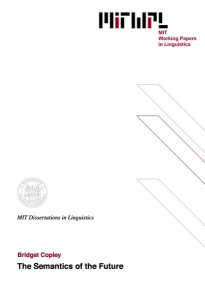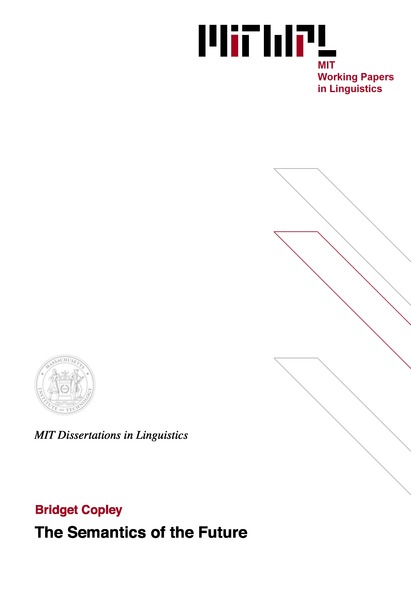The Semantics of the Future
B. Copley, 2002
Natural languages use a number of different methods to refer to future eventualities: among them are futurates, as in (1a), and futures, as in (1b) and (1c).
(1) a. The Red Sox (are) play(ing) the Yankees tomorrow.
b. We’ll change your oil in Madera.
c. We’re going to change your oil in Madera.
This dissertation uses evidence primarily from English, with additional data from Turkish and Indonesian, to argue that these methods all involve universal quantification over subsets of metaphysically accessible futures.
One factor in determining which worlds a modal quantifies over is the temporal argument of the modal’s accessibility relation. It is well-known that a higher tense affects the accessibility relation of modals. What is not well-known is that there are aspectual operators high enough to affect the accessibility relation of modals. New data presented in this dissertation reveals the presence of aspectual operators located between TP and the future modal projection. The effects of these operators on truth and assertability conditions provide substantial information about the correct characterization of future modality, and indeed of modality in general. Furthermore, the very existence of such aspectual operators raises questions about how aspect is represented in the semantics, if, as is generally assumed, aspectual operators take event arguments, which do not occur outside of the verb phrase.
In addition, the ordering source in futures is found to be determined in some cases by animate entities’ abilities and commitments (bouletic ordering sources), and in other cases by more general properties of the world (inertial ordering sources). Since other modals in other languages seem to share this property, a unification of the two kinds of ordering sources is proposed.
Thesis Supervisor: Sabine Iatridou
Title: Professor of Linguistics
<br/>
Table of Contents
1 Introduction 13
1.1 Tools 15
1.1.1 Syntactic assumptions 15
1.1.2 The intensional system 15
1.1.3 Tense, aspect, and temporal adverbials 16
1.1.4 Talking about times 20
1.1.5 Modality 21
1.1.5.1 The modal base 22
1.1.5.2 The ordering source 23
1.1.6 Branching futures: times and worlds 24
1.2 Overview 26
2 Futurates 29
2.1 Futurate meaning 30
2.1.1 An initial hypothesis 31
2.1.2 Disadvantages of this approach 34
2.1.2.1 A problem with the assertion 34
2.1.2.2 The need for a presupposition 34
2.1.3 Argument for a smarter grammar 36
2.1.4 Intuitions about plans 38
2.1.4.1 On being committed 39
2.1.4.2 Ability 41
2.1.5 A solution 42
2.1.5.1 Formal beginnings 43
2.1.5.2 Scopal relations in the definition of direction 47
2.1.5.3 Ability and accidental directors 48
2.1.6 Simple futurates 49
2.1.7 Futurates without directors 54
2.1.8 Summary 57
2.2 Mapping futurate meaning onto morphosyntax 58
2.2.1 The location of All-b 58
2.2.2 All-b in progressive futurates 59
2.2.2.1 Dowty’s modal progressive 60
2.2.2.2 Ongoing readings of the progressive 63
2.2.2.3 A temporal issue 64
2.2.3 All-b in simple futurates 66
2.2.3.1 Ordering in generics 67
2.2.3.2 The Principle of the Excluded Middle revisited 68
2.2.3.3 Generics and the simple futurate presupposition 69
2.2.3.4 Summary 70
2.2.4 On directors in the syntax 70
2.3 Conclusions 73
3 Futures 75
3.1 Ordering and aspect in futures 79
3.1.1 Ordering in futures 80
3.1.1.1 Inertial and bouletic construals of futures 80
3.1.1.2 Different directions 82
3.1.1.3 Inertial differences 84
3.1.1.4 Bouletic differences 85
3.1.1.5 Summary 86
3.1.2 Aspect in futures 86
3.1.2.1 Present temporal input 87
3.1.2.1.1 Contexts that rule out generics 88
3.1.2.1.2 Some unbelievable data 89
3.1.2.2 Indefinites 92
3.1.2.3 Distinguishing bare and generic will 93
3.1.2.4 Summary 94
3.2 Aspect constrains the accessibility relation 94
3.2.1 The pragmatics of offering 95
3.2.2 Back to the billboard 97
3.2.3 Proposal 99
3.2.4 Explaining the puzzle 101
3.3 Aspectual-modal interactions in past futures 104
3.3.1 Fate-in-hindsight 104
3.3.2 No past bouletic generics 106
3.4 Dispositional will 108
3.4.1 Genericity in dispositional will 108
3.4.2 Dissimilarities with generic will 109
3.4.3 Hypothesis 110
3.4.4 Facts from Indonesian 112
3.5 Conclusion 113
4 Conditionals 115
4.1 Conditional contexts 120
4.1.1 Relevance conditionals 121
4.1.2 Indication and causal contexts 123
4.1.3 Wide scope be going to 126
4.2 Main verbs and the complement SIP effect 130
4.2.1 Wide be going to has the complement SIP effect 131
4.2.2 Bare will has the complement SIP effect 134
4.2.2.1 On the scope of bare will 135
4.2.2.2 On the missing readings of bare will 136
4.2.3 Summary 137
4.3 Implementing the mechanism 137
4.3.1 The mechanism 138
4.3.2 Temporal interpretation of antecedent and consequent 141
4.3.2.1 Lemma 1: Type 1 conditionals 142
4.3.2.2 Lemma 2: Type 2 conditionals 144
4.3.2.3 Which conditional is which? 149
4.3.2.4 Why the SIP value of p doesn’t matter 150
4.3.3 Formal details 152
4.3.3.1 Temporal location and aspect 152
4.3.3.2 Denotation of Ep 153
4.3.3.3 Denotations of type 2 modals 154
4.3.3.4 Summary 154
4.4 Simultaneous states 154
4.5 Conclusion 157
5 Conclusion 159
5.1 Facts explained 159
5.2 Remaining questions 160

